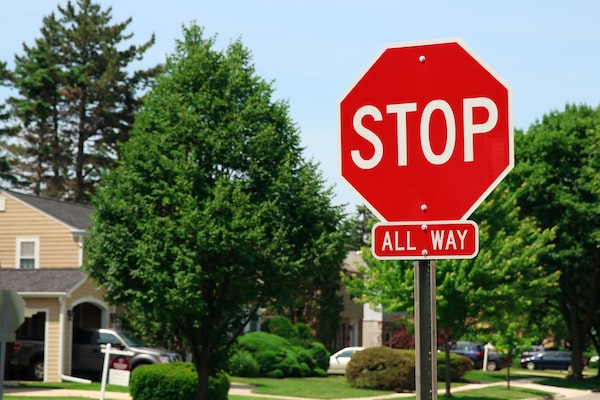
Saklakova/iStockPhoto / Getty Images
I prefer driving on side streets and, often, I end up following another car from stop sign to stop sign. Here’s a regular occurrence: at four-way stops, the car in front of me stops, then proceeds through the intersection. As they accelerate, I pull up to the line. Then, another car pulls up to my left or right. As the car in front of me clears the intersection, the other car starts to go. But I got to the stop sign first, so isn’t it my turn? – Jordan, Toronto
Four-way stops are supposed to be like a Starbucks: first come, first served.
“If someone clearly comes to a complete and utter stop in the correct stopping position, that person should be afforded the right to go first because we’re Canadians and we share stuff,” says Angelo DiCicco, director of operations at Young Drivers of Canada’s advanced driving centre.
So, if you’re the first one to come to a complete stop, you have the right of way.
But if another car goes anyway, maybe the driver didn’t see you come to a stop. Or maybe they thought they got there first. Or maybe they’re a jerk.
But once their car’s nose passes the stop line and they start to go through the intersection, they get the right of way, no matter who really got there first.
“It is the vehicle that enters the intersection first that gets control of the intersection” Ian Law, president and chief instructor of ILR Car Control School, writes in an e-mail. “Others should wait until that vehicle clears the intersection before they enter the intersection.”
So, what if two cars get to the intersection at about the same time, and it’s too close to call? Then you should yield to the car on your right.
“Then you should let the person on your right go first, and once they’re gone, it’s your turn,” DiCicco says. “That’s why we call it right of way and not left of way.”
If it’s more than two cars, then it should go clockwise until every car gets their turn, DiCicco adds.
Two to tangle?
So, what if you get to the intersection at about the same time as the car opposite you and you’re both going straight?
Theoretically, you can both go straight at the same time and most people will do that, DiCicco says.
Same goes if you’re both turning right. If you’re both turning left, it can get a little more dangerous.
“You can do it, but you’d better have … really good observation skills and trust,” DiCicco says. “Sometimes people do this in their local neighbourhoods. But if somebody else cuts through that part of town, there can be trouble.”
If you do have the right of way at a four-way stop, you shouldn’t be waiting to take it. If you wait too long, somebody else will take your turn.
“People at an all-way stop think it’s time to stop and have a sip of coffee, and they’re wrong,” DiCicco says. “They’re giving up their right of way, and it’s confusing [for] everyone else.”
It’s a good idea to scan the intersection before you even stop to see who’s approaching and who should be going next. If it’s your turn, and it’s clear once you get there, you should go.
“If you’re overly conscientious, and you’re taking two or three seconds before you go, you’re actually making it more dangerous,” DiCicco says. “Things get clogged up, and you get frustrated people who take the right of way.”
Have a driving question? Send it to globedrive@globeandmail.com. Canada’s a big place, so let us know where you are so we can find the answer for your city and province.
Stay on top of all our Drive stories. We have a Drive newsletter covering car reviews, innovative new cars and the ups and downs of everyday driving. Sign up today.